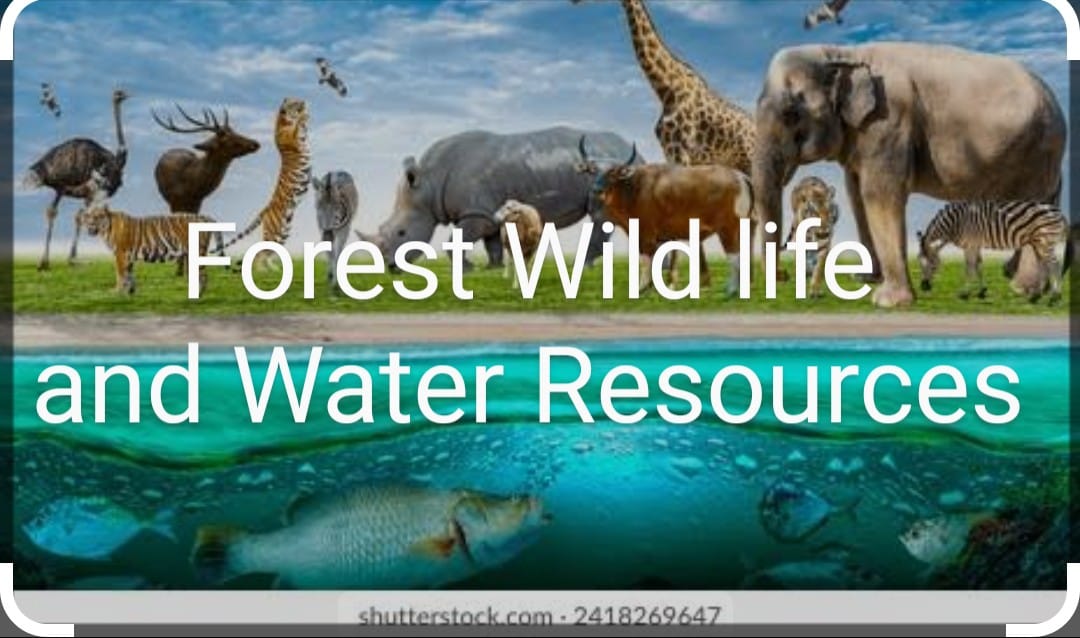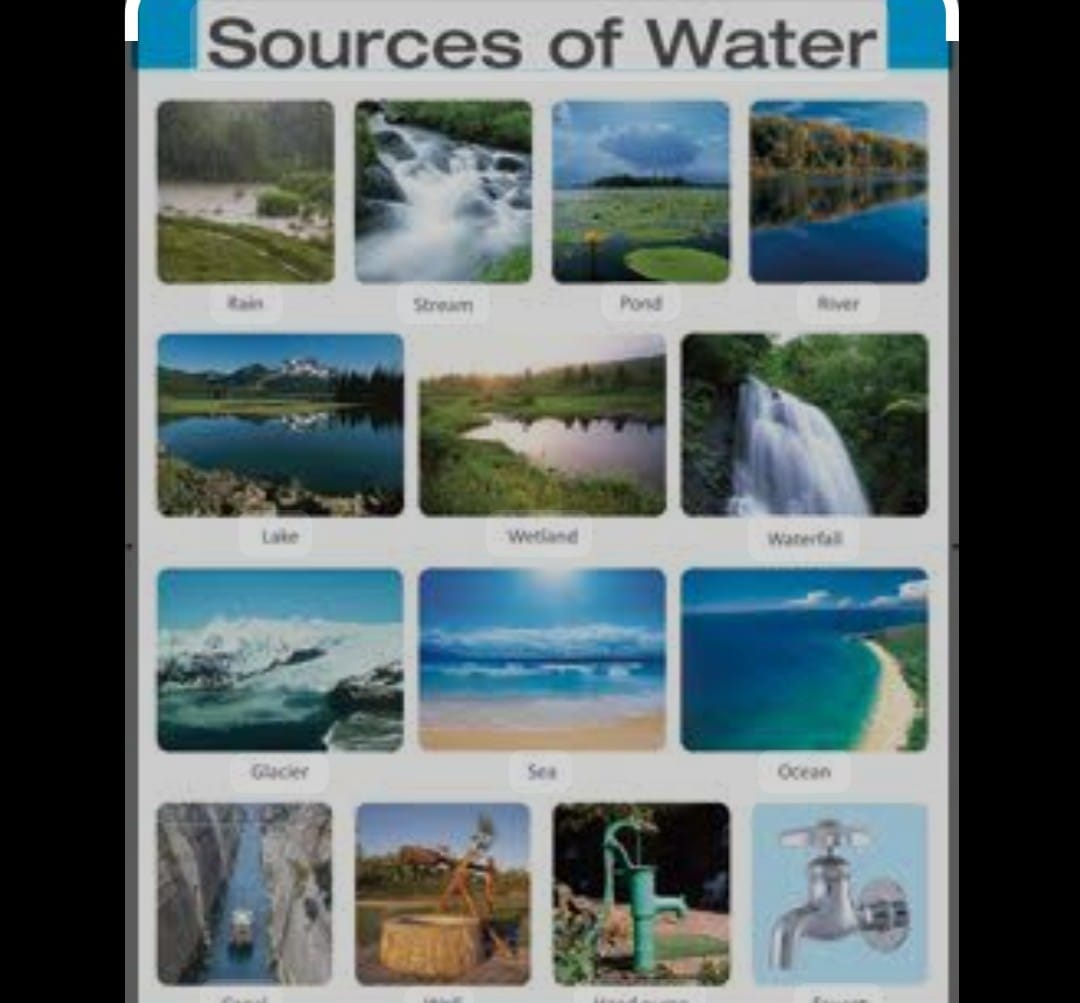Forests Wild life and Water Resources
Forests wild life and water Resources is two chapter from Social Science that covers the complete syllabus of class 10th

Forests and Wild Life

INDIA is the richest in its flora that is the plants of a particular region .IT has about 47ooo plant species and about 15000 flowers species. Our country is also rich in fauna the animals of different species.
It has more than 81000 of animals species, there are more than1200 species of birds,2500 of fish and more than2500species of insects.
There are five types of forest in India
a)Tropical evergreen forest
b) Tropical deciduous forest Thron Forest, mangrove forest, mountain forest.
Conservation of forest and wildlife:
There has been rapid decline in the wildlife population and forestry. Conservation preserves the ecological diversity and our life support system such as air ,water and soil It also preserves the genetic diversity of plants and animals for better growth and breeding. During year 1960and 1970 the conservationist demanded a national wildlife protection programme
.IN 1972 THE INDIAN WILDLIFE (protection) ACT was implemented with various protection provisions such as banning the hunting, giving the legal protection to the habitats and banning the trade of wildlife animals.
For which central and state government have established the national Parks and wildlife sanctuaries. there are some animals which have been given legal protection against hunting and trade throughout India they are tiger, the horn rhinoceros, freshwater crocodile, saltwater crocodile, Keshmiri stag/hangul, the gharial, the Asiatic lion, the Indian elephant, black buck /chinkara, the great Indian bastard /godawan, the snow leopard.
PROJECT TIGER:
In 1973 it was realized that the population of tigers was declining it was 1827 due to poaching for trade, shrinking habitat depletion of prey base species. The trade of tiger skin and it’s bone for making medicine in most of Asian countries have reduce the population of tiger in very large amount to the level of extinction.
India and Nepal provide habitat to most of the tiges in the world therefore these two countries are the prime Centre of poaching and illegal trading, so the project tiger was launched in that year.
CORBETT NATIONAL PARK IN UTTRAKHAND, SUNDERBAN NATIONAL PARK IN WEST BENGAL, BANDHAVGARH NATIOAL PARK IN MP, SARISKA WILDLIFE SANCTUARY IN RAJASTHAN, MANAS TIGER RESERVE IN ASSAM, PERIYAR TIGER RESERVE IN KERLA are well known project to protect wildlife and tigers. In 1980 and 1986 butterflies, moth ,beetles ,dragon fly was included and in1996 six species of plants were also included in this list.
DISTRIBUTION OF FOREST:
The forest is classified into following class
a) Reserved forest more than half of the forest land has been declared the reserved forest they are most valuable as they are conserved and wildlife resources.
b) Protected Forest one third of total forest come in this category they are protected from further depletion.
c)unclassed forest they are other forest and wasteland belonging to Andhra Pradesh,
Uttrak hand, Kerala Tamil Nadu ,West Bengal Maharashtra have large percentage of reserve forest whereas Bihar, Haryana Punjab Himachal Pradesh Odissa Rajasthan are under protect forest.
COMMUNITY AND CONSERVATION :
There are some local communities struggling to conserve the habitats along with government officials to secure their long term live hood .In Rajasthan, The Sariska tiger reserve village have conflict against mining by citing Wildlife Protection Act. The inhabitants of five villages in Alwar districts have declared 1200 hectares of forest as Bhairodev Dakav Sonchuri declaring their own set of rules which don’t allow hunting any outsiders.
CHIPKO movement in the Himalayas against deforestation,
BEEJ BACHAO ANDOLAN in Tehri,
NAVDANYA is the diversified crop production without use of chemicals are possible and economical
IUCN stands for international union for conservation of nature divided the species as
a) Normal Species whose population levels are considered to be normal for the survival such as cattle, Sal, pine , rodents.
b) Endangered species are those which are danger in extinction ,the survival of such species is difficult if negative factions continue to operate. such as blackbuck, crocodile Indian wild ass, Indian rhino, lion tailed macaque Sangari. c) Vulnerable species are those whose population has been declining to the level where it is likely to move in endangered category in near future. such as blue sheep, Asiatic elephant Gangetic dolphins ,
d)Rare species are those having a small population may move into entangled / vulnerable category if negative factors continue such as Himalayan brown bear, Asiatic buffalo, desert fox hornbill.
e) Endemic species those which are found in particular aera usually isolated or geographical barriers. such as Andaman teal, Nico ban pigeon, Andaman wild pig Mithun in Arunachal Pradesh
f) Extinct species which are not found after many searches of known as Asian tic cheetah, pink head duck.
CAUSES FOR FOREST DEPLETION:
a) Expansion of agricultural
b) Large scale development projects as railway, river valley projects.
c) mining in forest
d) Colonial Forest policies
d) over population, habitat destruction, over exploitation of resources, forest fire
NEED FOR BIODIVERSITY: It is very essential to conserve our biodiversity which will preserve the ecological diversity ,preserve our support system of life ,genetic diversity of plants and sustain the quality of life.
WATER SCARCITY AND NEED FOR WATER CONSERVATION

When we think about water scarcity we imagine about the places with low rainfall. like Rajasthan. The availability varies from place to place and seasons but it is caused due to over exploitation main cause of depletion in most of the aeras, excessive use ,unequal access to water among different social groups.
Large population increase the demand for water to do the domestic work and preparation of food for agriculture production more water is required in form of irrigation. The fresh water is obtained precipitation surface run off and ground water. Most of the farmer have their own wells or tubewells to obtain water for irrigation.
After independence more focus was given to industrialisation and urbanisation open way of our development it is exerting the pressure on freshwater.
They are the heavy user of water and require power to run which comes from hydroelectric power 22% of total production of power. There are some places where sufficient amount of water is present, but quality of water is very poor due to domestic, industrial waste chemicals, pesticides fertilizers used in agriculture.
The government of India has given the highest priority to improve the quality of life in rural aera by JAL JEEVAN MISSION the aim to bring potable piped water at the service level of 55 liters per capita per day to every rural household.
If we conserve water resources it safeguards our health problems, ensure food security, continuation of livelihoods and productive activities, prevent degradation of ecosystem.
MULTI-PURPOSES RIVER PROJECT:
Dams play an important role to conserve water previously they were impound rivers and rainwater for irrigation but now it is also used for generating electricity, water supply to domestic purposes, industrial uses, flood control, recreation, fishing and inland navigation.
Example
BHAKRA NAGAL DAM on the Sutlej Beas River used for generation of electricity,
HIRAKUD DAM on the Mahanadi basin used for flood control and conservation of water.
Dams if having positive effects have many negatives affects the natural flow of sediments does not take place the sediments collect at bottom become rockier stream bed which affect the aquatic life,framentation of rivers takes place which make difficult aquatic fauna to migrate, reservoirs created during floodplain submerge the vegetation and soil of the .
This is the main cause for environmental movement such as NARMADA BACHAO ANDOLAN control by NGO moblised by farmers, environmentalist and human right activists because SARDAR SARAVOR DAM was built on the Narmada river ,
TEHRI DAM ANDOLAN.
It caused many disputes between farmers of Sabarmati of Gujarat for not giving water supply to Rural aeras during droughts., many other problems have been created as land degration,water borne diseases earthquakes pollution due to excessive use
| RAIN WATER HARVESTING:
The best method of water conservation is rainwater harvesting, in hills and mountainous region people bult gul/kuls for agriculture, in Rajasthan rooftop rainwater is harvested or stored for drinking, in Bengal inundations channels are developed for irrigation. In arid or semi-arid places agricultural fields were converted into rain fed storage structures that allowed water to stand and moisten the soil known as KHADINS in Jaisalmer and JOHADS in other parts of Rajasthan. The rainwater is stored in big tanks. Rainwater /Palar pani is referred to these parts as purest form of water. Now the system of making underground tanks have decline due to INDRA GANDHI CANAL providing perennial water to these area. INTERSTING FACTS: a) In first century by Sringavrapura near Allahabad had sophisticated water harvesting system on river Ganga b) During Chandragupta Maurya many dams lakes etc. were built in KALINGA (Odisha) NAGARJUNKAKONDA (Andhra Pradesh) BENNUR (Karnataka) KOLHAPUR (Maharasthra) c) Bhopal Lake largest artificial lake built in 11 century d) tank in HAUZ KHAS Delhi was constructed by IITUTMISH for supply water Siri fort area. e) Tamil Nadu was the first state in India to make compulsory Top roof rainwater harvesting. Conclusion : Forest wild life and Water ResourcesIn Forest Wild Life and Water Resources itis fact that Forest is habitat for diverse wildlife. It has Critical role in water cycle and resource management. Wildlife in forests represent Biodiversity and Ecological balance and food chains. Water resources in forests are Watershed protection They are Natural water filtration and storage. There are Conservation challenges like Deforestation, Climate change impacts and Human encroachment There is great need of Sustainable management by Balanced approach to forest use and preservation and giving Importance to conservation efforts. |
|
| Read More : Resources and Development | Adde |
| Read More : Mineral and Energy Resources | Added: |